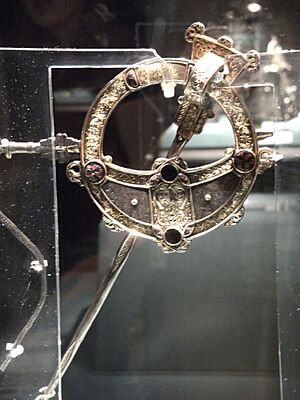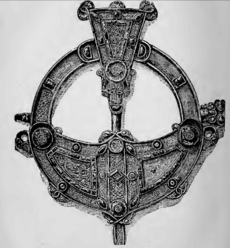Tara Brooch facts for kids
Quick facts for kids Tara Brooch |
|
|---|---|

Front and rear views
|
|
 |
|
| Material | silver, gold, glass, enamel, amber |
| Size | diameter 8.7 cm |
| Created | 650 to 750 AD |
| Discovered | 1850 (reportedly) Bettystown |
| Present location | National Museum of Ireland, Dublin |
The Tara Brooch is a famous piece of Celtic art from early medieval Ireland. It is a type of brooch called a pseudo-penannular brooch, which means it looks like a ring that isn't quite closed. This amazing brooch was made between 710 and 750 AD.
It was found in Ireland in 1850. Even though it's called the Tara Brooch, it wasn't found at the Hill of Tara. It was likely found near Bettystown in County Meath. A jeweler bought it and gave it the name "Tara Brooch" to make it more popular. The brooch was shown around the world and helped start the Celtic Revival in the mid-1800s. Today, you can see it at the National Museum of Ireland in Dublin.
Experts at the National Museum of Ireland say the Tara Brooch shows how skilled Irish metalworkers were long ago. They say "Each individual element of decoration is executed perfectly and the range of technique represented on such a small object is astounding."
Contents
What is the Tara Brooch Like?
The Tara Brooch is about 8.7 centimeters (about 3.4 inches) wide. Its long pin is 32 centimeters (about 12.6 inches) long. It is made from silver that was melted and poured into a mold, then covered with a thin layer of gold. This is called silver-gilt.
Detailed Decoration of the Brooch
The brooch is decorated on both its front and back. The front has very fine gold designs called filigree. These designs show animals and abstract shapes. Small pieces of glass, enamel, and amber are set into the brooch.
The back of the brooch is flatter than the front. Its designs were made by casting, which means the metal was poured into a mold with the designs already in it. These designs include swirls and triple spirals.
Special Features of the Brooch
A silver chain is attached to the brooch. This chain is made from plaited (braided) wire. It connects to the brooch with a special swivel part. This swivel looks like animal heads holding two small glass human heads.
Where Was the Tara Brooch Found?
The Tara Brooch is named after the Hill of Tara. This hill was traditionally known as the home of the ancient High Kings of Ireland. However, the brooch has no real connection to the Hill of Tara or the High Kings.
The Real Discovery Location
The brooch was supposedly found in August 1850. It was found on the beach at Bettystown, near Laytown, in County Meath. This area is not far from Drogheda. It is about 50 kilometers (30 miles) north of Dublin. It is also about 25 kilometers (15 miles) from the Hill of Tara.
A local woman, or her two sons, claimed to have found it. She said it was in a box buried in the sand on the beach. However, it is more likely that it was found inland. She might have said it was found on the beach to avoid legal problems with the landowner.
How the Brooch Got Its Name
The brooch was sold to a dealer. Then, a Dublin jeweler named G. & S. Waterhouse bought it. This company was already making jewelry inspired by Celtic designs. They renamed it the "Tara Brooch" to make it more appealing to the public. This helped them sell more copies.
When the brooch was found, only one small decorated piece was missing. But since then, several more pieces have disappeared. This happened before it became part of the Royal Irish Academy's collection. Later, this collection was moved to the new National Museum.
Images for kids
See also
 In Spanish: Broche de Tara para niños
In Spanish: Broche de Tara para niños




